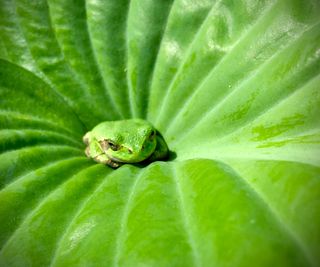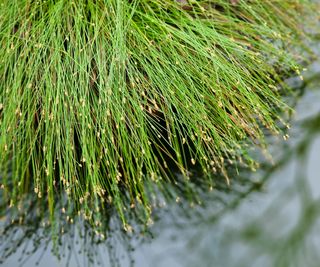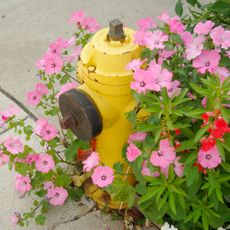Best Plants For Frogs: 7 Plant Varieties To Bring More Froggies To Your Yard
A frog-friendly environment is one of the key indicators for garden health – so if you want to improve the health of your plot, here are seven plants for frogs you need to try


There can be few sights more comforting for gardeners than spotting frogs in the garden. Growing plants for frogs will enhance your growing pleasures in multiple ways. Not only will you be increasing your backyard’s local wildlife count, with all of the sounds and sights this inspires.
You will also be helping to manage numbers of insects such as beetles, mosquitoes, slugs, snails and flies, which frogs love to eat. By attracting frogs to the garden, you are effectively helping to improve biodiversity levels. Put simply, the presence of frogs and toads is a sign that things are working as they should in the natural order of your plot.
The plants you choose to help with building a frog habitat and small frog pond ideas will need to cover off a few key functions – providing shelter, a variety of areas to rest, breed and nest, and a source of food via insect-attracting blooms. It’s also important to go native wherever possible. Here are seven plants to cover off all the bases for happier frogs and toads – and a healthier, balanced backyard environment into the bargain.
7 Best Plants For Frogs And Toads
Selecting plants for frogs requires a little lateral thinking. To create an amphibian-friendly habitat, you should be factoring in a range of shapes, textures, angles, heights and flowering seasons.
Some plants will have to support frogs at the ground-cover level with hiding places, while others benefit from towering high enough to provide climbing frames. Pond-based plants need to balance ground-based alternatives. Plants for a frog pond should supply food sources and shelter, as well as helping to keep water levels healthy and ideally algae-free.
Going with native, pollinator-friendly plants allows you to be sure you are attracting peak numbers of insects, which will allow frogs and toads to thrive. Doing this in tandem with insect hotels and wildflower patches will maximize your chances of catering to your amphibian guests.
It’s also a good idea to assess your backyard spaces and make sure that you aren’t overwhelming the space with too much lawn (yes, that is a thing when it comes to frogs and toads!). Picking plants for a frog garden is about making these beneficial garden animals feel safe, comfortable, well fed and happy to stay and breed.
Gardening tips, videos, info and more delivered right to your inbox!
Sign up for the Gardening Know How newsletter today and receive a free download of our most popular eBook "How to Grow Delicious Tomatoes."
1. Water Lilies

Water lilies make serene aquatic plants for frogs and shelter for tadpoles, as well as being some of the prettiest plants you can grow. Their broad flat leaves afford the ideal surface for resting, while the flowers entice insects. Each individual leaf that forms this striking perennial is capable of reaching 12in (30cm) in diameter, so make sure your pond can hold several.
Also, when growing water lilies, make sure you maintain good airflow and space between individual plants (Nymphaea odorata), and check they can receive six-eight hours of sunshine per day. Other than that, their needs are few. These are, quite simply, some of the best pond plants for frogs.
2. Frogfruit

Alongside water-based plants, of course, your froggie friends are going to need some effective ground cover plants to help with shade and shelter. Frogfruit plants (Phyla nodiflora) make great ground cover for partial shade as well as sunshine, so they can be grown in a range of gardens.
These are some of the fastest-growing plants for frogs, and are good for encouraging pollinators to your plot because they have a long flowering season, which lasts from April to October. Frogfruit plants are also relatively drought-tolerant once established.
3. Hostas

There is something reassuringly straightforward and reliable about growing hostas, also known as plantain lilies. Their intrinsic allure for frogs lies in their enormous leaves, which provide shade on hotter days and shelter during chillier moments. Alongside that, they come in all manner of tones and variegations, so they add easy value to gardens large and small.
They also attract the attention of some of the frog’s favorite food supplies in the form of slugs! This makes hostas a win-win for frog-loving plant growers after a quick way to control mollusc numbers in their garden.
4. Wild Bergamot

Also known as bee balm, wild bergamot (Monarda fistulosa) is a member of the mint family. It is charaacterized by fragrant foliage and large, shaggy purple flower heads which bloom from midsummer to fall. These striking blooms are a respectable source of nectar, bringing all manner of insects into the crosshairs for hungry frogs. For anyone serious about growing a native garden to encourage as many insects as possible, wild bergamot is essential for frog-friendly environments.
5. Sedge

For an extra element of protection around the edges of a pond, sedges make some of the most densely packed foliage plants for frogs. Capable of reaching 3ft (90cm) tall, the stems of sedge plants are ideal for both filling and cleaning ponds and keeping frogs safe.
You’ll also find that growing sedge gives you an opportunity to experiment with different varieties. Some forms, like red-fruited saw sedge, have frothy flower heads and arching, blade-style leaves. Others, like tussock or upright sedge, form dense clumps of bright green feathery foliage.
6. Pickerel Rush

Aquatic pickerel rush (also known as pickerelweed, Pontederia cordata) is an excellent plant for cultivating insect populations that form the basis of a frog’s diet. With its tall, shiny leaves and lavender-style purple and pink floral bracts, it also adds ornamental splendor to the edge of a pond. Pickerel rush plants are also some of the most straightforward to grow.
As long as they aren’t left to dehydrate or wither in shade, growing pickerel rush plants is enjoyably low maintenance. Capable of reaching 30in (75cm) tall, these purple-topped beauties add shelter and visual interest, being attractive to dragonflies as well as bees and butterflies.
7. Swamp Milkweed

As well as being a firm favorite of the Monarch butterflies, swamp milkweed (Asclepias incarnata) is popular with several insects that provide ample food sources for frogs. As its name suggests, swamp milkweed is happy in moist conditions and flourishes in wet environments (just remember to find it a place somewhere sunny).
With its frothy pink floral clusters and pointed green foliage, this statuesque perennial makes a flamboyant addition to a frog-friendly garden. By growing swamp milkweed, you’ll help to maintain relatively high levels of moisture, which frogs need, and keep them well covered.

Janey is a former assistant editor of the UK’s oldest gardening magazine, Amateur Gardening, where she worked for five years. For the last few years, she has also been writing and editing content for digital gardening brands GardeningEtc and Homes & Gardens. She’s taken part in a range of conservation and rewilding projects for the Royal Horticultural Society (RHS) and the British Trust for Conservation Volunteers (BTCV) as a way of exploring her horticultural horizons. She is currently undertaking her RHS Level 2 certificate in The Principles of Plant Growth and Development.
-
 How To Keep Peonies From Falling Over: 5 Fixes For Floppy Flowers
How To Keep Peonies From Falling Over: 5 Fixes For Floppy FlowersPeonies are cottage garden favorites, but they can be prone to flopping. Support peonies with these practical ideas that can double as attractive features.
By Melanie Griffiths
-
 9 Bird-Friendly Flowering Plants: Flowers That Attract Birds Through The Seasons
9 Bird-Friendly Flowering Plants: Flowers That Attract Birds Through The SeasonsChoose the right flowering plants and your garden will become a favorite hangout for avian visitors. Try these nine flowers that attract birds to your yard
By Tonya Barnett
-
 9 Bird-Friendly Flowering Plants: Flowers That Attract Birds Through The Seasons
9 Bird-Friendly Flowering Plants: Flowers That Attract Birds Through The SeasonsChoose the right flowering plants and your garden will become a favorite hangout for avian visitors. Try these nine flowers that attract birds to your yard
By Tonya Barnett
-
 Support California Dogface Butterfly: Do More For Zerene Eurydice
Support California Dogface Butterfly: Do More For Zerene EurydiceWould you like to know how to support California’s state insect? We explain the vital pollinating role of the California dogface butterfly and how to help it in your backyard
By Teo Spengler
-
 Try These Hummingbird Vines: 8 Best Flowering Vines For Hummingbirds
Try These Hummingbird Vines: 8 Best Flowering Vines For HummingbirdsWant to improve your chances of attracting some of the world’s most charming avian visitors? Here are the best eight flowering vines for hummingbirds
By Tonya Barnett
-
 Beautiful Butterfly Garden Ideas: 10 Ways To Attract Pretty Pollinators To Your Yard
Beautiful Butterfly Garden Ideas: 10 Ways To Attract Pretty Pollinators To Your YardBringing butterflies to your backyard is one of the most important ways you can enhance wildlife, boost pollination and improve biodiversity. These 10 butterfly garden ideas can get you started
By Mary Ellen Ellis
-
 Landscaping Around A Fire Hydrant: Landscaping Tips And Safety Considerations
Landscaping Around A Fire Hydrant: Landscaping Tips And Safety ConsiderationsIt might not sound like the obvious choice for a landscaping project, but a fire hydrant can work with a bigger gardening vision. Follow our tips on landscaping around a fire hydrant
By Mary Ellen Ellis
-
 Planting For Chickens: Why You Should Plant A Chicken Garden
Planting For Chickens: Why You Should Plant A Chicken GardenIf you’ve never considered planting for chickens, this is your chance to enjoy their joyful benefits. We show you how to make an easy chicken garden
By Amy Grant
-
 Why It's Time To Raise Ducks For The Garden – Move Over, Chickens!
Why It's Time To Raise Ducks For The Garden – Move Over, Chickens!Others might call you quackers, but if you get some ducks for the garden, you can enjoy a host of plot-friendly benefits. Just follow our expert guide to make the most of these unique creatures
By Mary Ellen Ellis
-
 Dark Home Exterior? Choose The Right Plants With Our Expert Dark House Landscaping Tips
Dark Home Exterior? Choose The Right Plants With Our Expert Dark House Landscaping TipsIf the front or back of your house is very dark, what are the implications for the plants you grow? We reveal how understanding dark house landscaping can help you pick the right plants
By Susan Albert